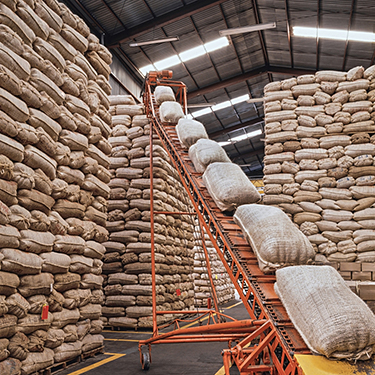THE OPEN
May beans: 4 1/4 lower
May meal: 1.10 lower
May soyoil: 3 lower
May corn: 1/4 lower
July wheat: 3/4 higher
Prices were subdued heading into today's Planting Intentions Report. Funds headed into the numbers net short corn, slightly long wheat, long meal, with neutral positions in beans/meal. Buy beans and wheat/sell corn trade dominated into the numbers, with unwinding of recent buy meal/sell soyoil spreads. It has not been unusual for corn prices to trend lower into the last several reports, and today was no exception, with traders expecting higher acreage. After the report, prices more or less stabilized in corn as values headed towards contract lows, suggesting the typical sell-the-story, buy-the -fact trade was in play.
At 11:00 the report was as follows:
QUARTERLY STOCKS (million bushels)
3/1/20 Avg High Low 12/1/19 3/1/19
Corn 7,953 8,162 8,492 7,892 11,389 8,613
Soybeans 2,253 2,237 2,701 2,075 3,252 2,727
Wheat 1,412 1,437 1,572 1,385 1,834 1,593
PROSPECTIVE PLANTINGS
ACREAGE (million acres) USDA USDA
3/31/19 Avg High Low 2018-19 3/29/19
Corn 97.0 94.3 96.4 92.5 89.7 92.8
Soybeans 83.5 84.7 87.0 82.7 76.1 84.6
Cotton 13.7 13.8
Grain Sorghum 5.8 5.1
All Wheat 44.7 44.9 46.0 42.3 45.2 45.8
Winter 30.8 30.8 31.7 30.1 31.2 31.5
Spring 12.6 12.6 13.4 12.0 12.7 12.8
Durum 1.3 1.5 2.4 1.1 1.3 1.4
Reaction to the report seemed to have been fairly muted and less volatile than in previous ones. If surprises offer the most bang for the buck, it was the corn acreage - well over the average estimate. The stocks number muted the response, however, coming in less than expected. Funds seemed to watch to see how much corn could go down before appearing to cover some of their short positions. Bean and wheat reaction suggests that current trading range levels were appropriate, with more liquidation in meal as oilshare strengthened.
Corn stocks as of March 1 were less than expected, totaling 7.95 bln bu and down 8% from year ago. Of those corn stocks, farmers were holding 4.45 bln bu on the farm, which is 13% lower than a year ago. Off-farm stocks at 3.5 bln bu were up sightly from the same period in 2019. Corn disappearance or use from Dec 2019 to Feb 2020 was 3.45 bln bu vs. 3.32 bln bu for the same period year ago.
Bean acreage at 83.5 mln acres was friendly, towards the lower end of trade expectations. Compared to year ago, planting intentions were up in 22 of the 29 reporting states, with the largest increases in Ark., Ill., Kansas, Michigan, Minn., Mo., and the Dakotas. Bean stocks at 2.25 bln bu are down 17% from year ago, but within expectations. Of those, USDA estimated 1.01 bln bu were stored on farm, down 20% from year ago, and 1.24 bln bu were stored off-farm, down 15% from year ago. USDA estimated bean usage for this past quarter (Dec 2019 - Feb 2020), totaled 1 bln bu, down 1% from year ago.
Wheat acreage was slightly friendly, with guesses just south of the average estimate at 44.7 mln acres, 1% below a year ago, and the lowest since 1919. Winter wheat areas at 30.8 mln acres is down from year ago, but within trade expectations. Spring wheat acreage was forecast to decline 1% from last year. Total wheat stocks at 1.41 bln bu was down 11% from year ago. On farm stocks were forecast at 339 mln bu, down 8% from year ago, while off-farm stocks were 1.07 bln bu, down 12% from year ago.
SOY
- Beans traded higher as oilshare pushed towards new highs as well. Unwinding of recent spread trade between meal and soyoil takes May meal towards the recent trading range lows of $320.00, while May soyoil trades in the early portion up towards 27c.
- July/Nov bean inverses are solidly higher trading up to 14 1/2c before the numbers were released, with July/Dec meal inverses slightly weaker trading to lows of $9.40 from $12.10.
- May soyoil seemed to have a bid as recent charts favor the upside, with breaks well supported. After the numbers, soyoil prices climbed higher as more traders unwound buy meal/sell soyoil trade.
- July crush traded to 1.13c/bu post report, with oilshare trading up to 30.0%.
- Beans found a bid on lower acreage and stocks, with prices still locked in sideways trade. However, the ability of the bean market to continue to bounce off recent lows remains impressive in terms of overall strength.
- July/Nov bean inverses were slightly weaker trading down to 7 1/2c from 14 1/2c as bulls booked profits. July/Dec meal was the same situation as bull-spreads were net sellers taking prices down to $8.60 from a firm $12.10 inverse high.
- Prices remained impressive today after the report, even for meal, which traded down to the lower end of recent ranges on end-of-month profit-taking.
GRAINS
- The path of least resistance remained lower for corn as funds sold lightly heading into the USDA report at 11:00.
- Ethanol futures remain lower as spot producers still have large net losses, and plants idled or shut down are balanced off by recent export activity.
- Spreads were slightly firmer into the USDA numbers with July/Dec trading from 11 1/4c carry out to 12 1/2c. Buy wheat/sell corn trade also persisted, as May corn dropped below the $3.40 level for a test of double lows at $3.38, with contract lows just a bit away at $3.32.
- Wheat futures gyrated back and forth, but still retained a bid into the report.
- May wheat/corn traded from 2.26 3/4c to 2.32c. Corn prices broke after the report, but funds decided to cover some of their shorts as prices approached recent contract lows.
- Closes today will be extremely important, but the corn bull appeared to rest easier, as the stocks number offset larger acreage numbers that may not come to fruition given the continued rainfall in the Delta and across the Midwest. Corn export inspections were healthy this week, as it appears as though consumers are taking advantage of weaker prices via the struggling ethanol market.
AT 12:00 THE MARKETS ARE AS FOLLOWS:
HI LO
May beans: 2 higher 8.87 1/2 8.75 3/4
May meal: 3.00 lower 326.90 320.30
May soyoil: 2 higher 2715 2668
May corn: 2 lower 3.42 1/2 3.33 1/2
July wheat: 3 higher 5.64 1/4 5.53 1/2
July canola: 3.10 higher 482.20 475.70
OUTSIDE MARKETS
Stocks continue on the defensive, down 150 pts after attempting to trade higher on the day. Crude trades to $21.89/barrel, with $19.85/barrel the lowest level since 2002. The S%P 500 could close out March with the worst three-month period since 1987, as investors weigh the impact of the virus on the economy. China's manufacturing number jumped to a reading of 52.0 in March from a record low of 35.7 in Feb, as reported by the National Bureau of Statistics.
CLOSING COMMENTS
Technically speaking, this was not a bad performance today for the soy complex and grains. The trade response to the numbers just reinforces the buy bean/wheat and sell corn spread trade.
With the tendency for March acreage to overshoot in the last few years, have to ask if this is the largest acreage number all year for corn? Weather remains wet in the Delta and the Midwest. There is time to dry out, but the deep south is not getting a break. There is very little weather premium now, and the reaction to the report seems to suggest that 97 mln acres of corn will be difficult to attain.
If short, would take this opportunity to get something on the books in terms of a profit. Wheat should remain supported by countries shutting down exports in lieu of the virus, and beans /meal may get a lift from Argentine port and crush struggles.
Closes today are extremely important, and the reaction in corn was not that bearish.
TAGS – Feed Grains, Soy & Oilseeds, Wheat, North America

 Wheat remains the star of the ag commodity space this week with the rally continuing on challenging weather prospects for the U.S. HRW region, Europe, and the Black Sea. Until a few weeks ago, there were few doubts about the 2024 crop being able to supply the expected demand, but now reduced yi...
Wheat remains the star of the ag commodity space this week with the rally continuing on challenging weather prospects for the U.S. HRW region, Europe, and the Black Sea. Until a few weeks ago, there were few doubts about the 2024 crop being able to supply the expected demand, but now reduced yi...
 Most Apparent Solution The EU’s organic sector wants the bloc’s officials to take more action to ensure they achieve the target of 25 percent of agricultural output being organic by 2030. Specifically, they want a campaign to increase consumer demand for organic food so that organic...
Most Apparent Solution The EU’s organic sector wants the bloc’s officials to take more action to ensure they achieve the target of 25 percent of agricultural output being organic by 2030. Specifically, they want a campaign to increase consumer demand for organic food so that organic...
 Yesterday, the Animal and Plant Health Inspection Service (APHIS) issued a federal order requiring testing and reporting of highly pathogenic avian influenza (HPAI) for the interstate movement of lactating dairy cattle. Specific guidance will be issued at some point today, and the order will go...
Yesterday, the Animal and Plant Health Inspection Service (APHIS) issued a federal order requiring testing and reporting of highly pathogenic avian influenza (HPAI) for the interstate movement of lactating dairy cattle. Specific guidance will be issued at some point today, and the order will go...